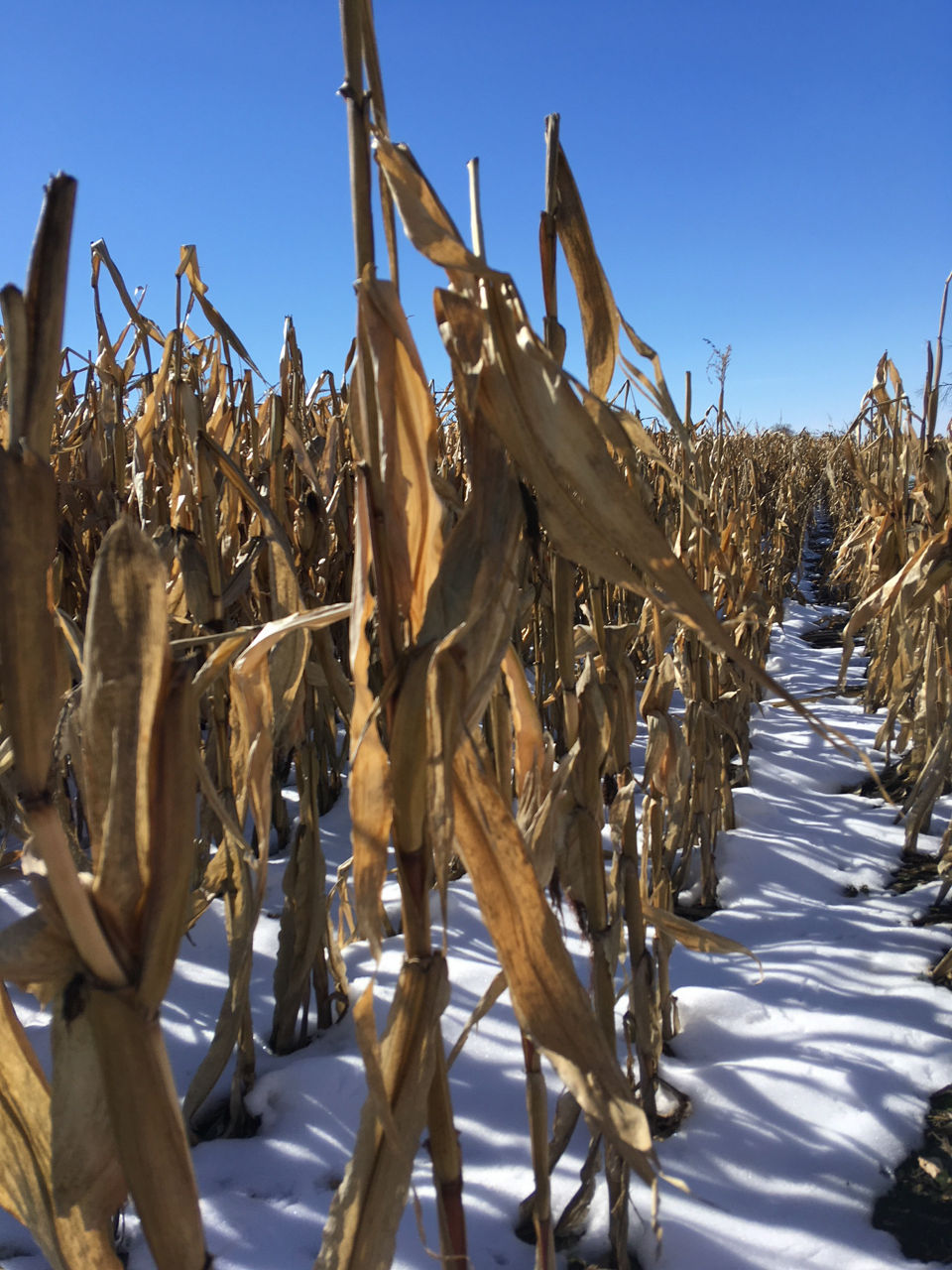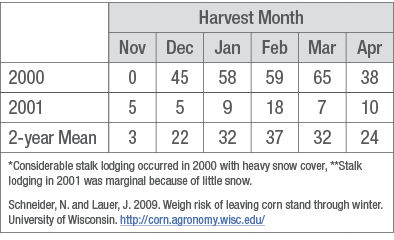Effects of Delayed Harvest Due to Snow
February 27, 2023
A delayed corn or soybean harvest due to snow can have a substantial impact especially if harvest is delayed until after mid-November. The impact can be more than just preharvest grain loss and potential additional grain dying expenses. It can also cause additional wear and tear to harvest equipment along with the potential of crop insurance consequences. Every crop year has its own challenges, and depending on the production area, there is a possibility that a snow fall occurs prior to harvest. Losses vary from year to year and can increase with how long the crop is required to stand in the field before harvesting. A snow event may delay harvest only for a few days or weeks or it may delay harvest until next spring depending on the amount of snow that falls and the weather that follows the snow event.
Many factors can contribute to why the crop wasn’t harvested before a snow event, and often it is the result of the combined effects of several factors:
- The crop was planted late in the growing season due to:
- A failed first planting (hail, poor emergence or insect feeding pressure).
- Poor weather conditions during the optimal planting window.
- A product was selected with a maturity that was too long of season for the growing area or planting date.
- Fall harvest weather did not allow the crop to dry in a timely manner which delayed harvest.
- An unseasonably early snowfall event.
- A growing season with abnormally low accumulated heat units.
- Equipment breakdowns, the availability of harvest equipment or a labor shortage to run harvest equipment.
Depending on the amount of snow, air temperature, and additional moisture in the form of snow or rain, harvest may be delayed until the ground is frozen enough to support harvest equipment or until the following spring. Snowy fields can increase grain moisture content and increase wear and tear on harvesting equipment.
Crop Insurance Corn
If the crop is insured with multi-peril crop insurance and cannot be harvested before it snows, there are several actions that a producer should take after the snowfall occurs.
- Contact your crop insurance agent and report a loss.
- Continue your normal and customary harvesting practices, if possible.
- Document conditions for your acreage and the actions you take so you can receive an accurate claim payment, if one is due.
- An extension may be requested if you are unable to harvest by the calendar date for the end of the insurance period. Harvest must occur during the extension period if a window of opportunity arises. If not, the insurance provider may appraise the acreage to finalize the claim. Damage occurring after the window of opportunity to harvest is uninsurable.1
For additional information contact your local crop insurance agent.


Harvest Management After Snow
There are several management decisions to make after a snow event.
- Begin with considering if the revenue lost from the yield loss will exceed the cost of drying the crop once the combine can get back in the field.
- Consider the tradeoff between harvesting wet grain (maybe as high as 25% grain moisture) with in-field yield losses due to delayed harvest. How much in-field yield loss is tolerable if the alternative is $1.00 or more, per bushel drying cost?
- If harvesting the affected crop is economically viable, then patience is needed to allow the grain and soil conditions to dry before resuming harvest. Whenever possible, wait for the soil conditions to be favorable to avoid compaction and rutting and avoid or minimize tillage in fields with high soil moisture. This may mean waiting for the ground to freeze.
- Additionally, wetting and freezing can cause split pods and seed shattering in soybean (Figure 2), and crops with wet pods and husks can cause plant material to stick to the grain. This results in problems with cleaning the grain properly and is most troublesome when air temperatures are between 27 and 35 oF.
- Harvesting grain that is frozen and wet is hard on combines and can potentially damage equipment. Take time to adjust the combine settings, take preventative maintenance seriously, and make appropriate repairs.
- With the right conditions, standing corn can withstand overwintering understanding that standability and ear retention can vary greatly by product. Grain loss due to delayed harvest is minimal in November (0 to 5 bu/acre) but has the potential to increase substantially if harvest is delayed into the winter and spring months (up to 60 bu/acre losses; Table 1).2 Stalk lodging, ear drop, and wildlife feeding are the main causes of yield loss.
- Areas of the field where wind causes snow to drift into the field edge may need to be harvested separately from the areas where drifted snow is not a problem. Harvest opportunities depend on the amount of snow that is drifted into the field and the weather after that snow event. That area may need to be harvested in the spring after that snow has melted, but every year can be different.
- Lastly, consider how a delay in harvest until spring affects next year’s crop. Consider factors like potential labor shortages, fertilizer application shifts, additional risk for volunteer corn, and delayed planting.3
Table 1. Average percent corn yield loss for 2000 and 2001 when left in the field throught the winter. (Arlington, WI).

Sources
1 2019. Delayed harvest - wet conditions. United States Department of Agriculture. Risk Management Agency Fact Sheet.
https://www.rma.usda.gov/en/Fact-Sheets/National-Fact-Sheets/Delayed-Harvest---Wet-Conditions
2 Schneider, N. and Lauer, J. 2009. Weigh risk of leaving corn stand through the winter. University of Wisconsin, Extension Team Grains. http://corn.agronomy.wisc.edu/Web/Search.aspx
3 Licht, M. 2019. Managing Crop Harvest After a Snow. Iowa State University. Extension and Outreach. Integrated Crop Management. https://crops.extension.iastate.edu/blog/mark-licht/managing-crop-harvest-after-snow
Web sources verified 12/14/22. 1110_162352